MAGIC ANCIENT BEADS
Would you be able to feel the difference between wearing a genuine
ancient bead and a new factory made bead?
As the worlds oldest art form
stone beads reach back to the beginning of the human history.
Even the Neanderthals used
beads for
decoration and for ritualistic purposes in connection with burials.
For the person who lives in an open liquid field of possibilities
instead of being confined to belief systems, be it a scientific,
religious or whatever, ancient beads can be objects of concentration,
that can focus the mind in such a way that the brain gets in sync. In
such a laser mind we sometimes are able to decode interference
structures in life that otherwise would look
like meaningless chaos.
For such a conscious and super wakeful mind an old bead can have or
maybe more correctly can gain 'amulettic' power.
It can in the hands of such a synced mind act as a post modern talisman,
rechargeable like a battery and in this sense bestow the owner with
roots of his own reality, a reality that can open a channel of dreams,
passed on from great civilizations long forgotten in the same way that
it reconnects us with our own ancient biological past. There are dormant
operative systems in our brain, layers of archaic survival processing
systems that do not understand language, but operates within the realm
of feelings, intuition, symbols and analogue thinking.
Do not even for a second think that you are an individual only listening
to reason. The billion year old brain of yours will not even listen to a
fraction of this tiny top of the iceberg called reason and language.
That is why it gives a feeling to hold an ancient bead in the
hand.
In many cases ancient beads have been sleeping in the soil of mother
earth for centuries. However they will wake
up from their slumber once you pick them up and look at them. This
looking will transform both the bead and you.
This bead is original. You become original.
An original for an original
Here is my favorite bead: An absolutely wonderful buddhist prayer
bead with a natural crystaline eye. This Eye Bead is one out of a million!
When you look at this eye it will look back on you... In this way you
get a new eye to see through.
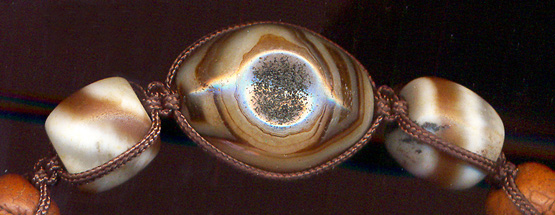
28 * 19
  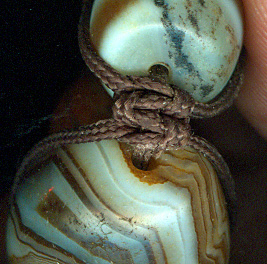
Click on picture for larger image
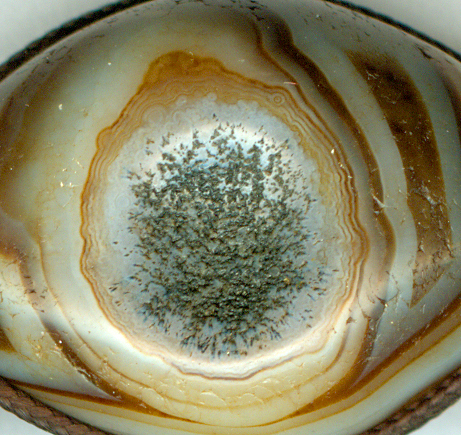
Close up of hole
Post Modern Bead Magic & poetic quantum physiscs
This magic bead has responded to my intentional and 'self created' power of belief
in such a way that in this moment I would not give it in exchange for even a nine eyed Zee-bead!
This is what I call Post Modern Magic. Post modern magic includes a conscious metalevel
where you are aware of the fact that it is your very belief that creates the magic.
It is like a situation where you are cured by placebo medicine even though you know it is placebo!
This understanding of Magic Realism is a product of a lifelong experience of a series of incidents where
my intentions have seemed to create situations that could not be explained by logic and statistic
coincidence alone. C.G.Jung termed this kind of phenomena with the word synchronocity.
With a little poetic help from the world of quantum physics I could say that it seems that
a focused human consciousnes is able to make small cracks in the space-time fabrics.
Of course you are not able to catch the moon because you wish so. But on a subtle level
there is still some kind of manipulation of time and space going on through a clear and directed thought
'awared' in a clear consciousnes. With these thoughts in mind I will return to the bead.
The real inside your Self
An ancient bead is able to respond like a microphone held close to a loudspeaker.
A feedback is created between your intentional and directed will power
and the bead, or should I say your knowledge of the bead as being a representative of
the ancient and the essential inside your self. A magic bead is in this way like a meditation device
helping you in the constant 'self remembrance' of your own true nature.
The bead should be felt on your skin. It should have direct contact with you as a living, breathing
and sweating bodily being. By this direct contact the bead's surface will be changed by you, while
your inner being will be changed by the bead.
Magic beads in a post modern context
This is for me the post modern way of using
a talisman or an amulet.
The post modern bead amulet has become real in a new level of understanding and will
protect you from the unreality created as a byproduct of a complex cyber civilization!
The ancient Eye
The concept of the protecting or the evil eye has been found in almost every ancient culture around the world.
Beads created as Eyes were typical as far back as the Neolithic period. Before world religions like Buddhism arrived
animism and shamanism ruled the spiritual world of human beings. In many ways it still does, especially in the
Theravada Buddhism and in the
Tibetan blend Vajrjana Buddhism and Bön. The social importance of ancient beads
cannot be understood, both today and thousands of years ago, without the animistic context in which it was
manufactured and used.
It shows as the bead displayed below, that the bead hole itself actually can be interpreted as a magic Eye.
One might say that the claimed
parallel between this bead hole and an eye is too far fetched. However we do not need to travel long back in
history before almost all arguments and search for higher meaning was founded, not in evidence based
logic, but in the persuading power in symbolic and analogue thinking.
In the Indus Valley culture there is evidence of the symbolic eye.
In the Indus bead displayed below one can clearly observe the
circular etching, that in the most simple symbolic form shows an Eye.
To the left below there an illustration of a Harappan King or High Priest.
To the right there is a photo of a Greek made head in stucco depicting
an Indian Buddhist King from the Mauryan Empire.
The illustrations clearly show similar designed eye-symbols.
The kings are linked through the head band ornaments they wear;
displaying what probably is a symbolic eye. These eyes are made in
the most minimalistic way possible, consisting of two concentric circles.
 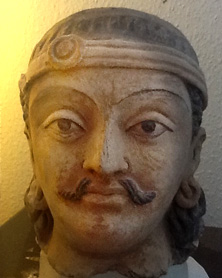
Harappan King Indian Buddhist King
The steatite Indus seal Beads below are ornamented with
similar designed eyes as one can observe in the Kings head bands.
They show the same double concentric circles
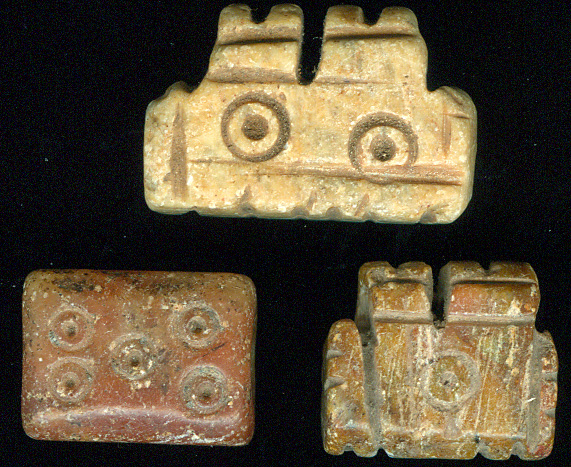
Indus Seal Eye beads in steatite.
Click here for more information
In the Indus bead displayed below again we find the same eye-logo
consisting of two concentric cirkles etched into the stone:
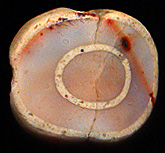
13 * 12 * 4 mm
Etched eye Bead
The illustrations above clearly shows the similarity in the design of eye-symbols
right from the Indus Valley Civilization and up to the Indian classical time.
This points, as much other evidence, at the cultural link connecting the
Indus Valley Civilization to the Indian classical time, especially the Indian,
Ashokan Buddhist civilization. As mentioned, the Indus Valley with its elitarian
and extreme culture, as still seen in its surviving form, the Jain religion,
became popularized in the form of the middle way seeking Buddhism from 500 B.C.
The all seeing Eye of God, King and State
Seen in the kingly or priestly context, the head band with the Eye
was likely to be a symbolic ornamental item of royal or imperial insignia.
It was most probably a manifestation of the all seeing Eye of the King and
the state, with either the ability to administer spiritual blessings or punitive
actions, delivered according to the law of karma, not only seen as
an abstract spiritual force, but also as the 'will' of the Empire.
The Third Eye as the magic Eye
In the case of an enlightened and just Emperor like the great Buddhist
King Asoka, it would therefore be more fitting to talk about the good Eye
than the more in folklore common, evil eye. It is also tempting to relate the
head band insignia Eye to the Indian notion of the spiritual all seeing Third Eye.
Seen from that perspective it is interesting to observe the
seemingly casual way the Buddhist King to the right has put the
all seeing Third Eye; not in the center, but to the right side.
This makes together with his almost sorrowful, deep, subtle and peculiar
individual face expression to an almost too human king; too aware of
the great responsibility it is to rule an Empire. By putting the head band
eye to the side, he also is putting himself aside, making way for
a spiritual power greater than his own human and frail assessments;
namely the all pervading compassion and knowledge of Lord Buddha himself.
Seen in comparison the Harrapan priest looks almost arrogant.
There is no place in space for a higher power than this priest himself.
Here I would like to sum up following thesis.
The Eye was original a symbol of a royal and spiritual protective power.
As the King and also before him the High Priest was looking after his
people, in case of war, famine or spiritual attacks from predatory
animistic entities, so you are also protected from the Evil Eye if you somehow
have come in possession of the good all seeing Third Eye of the King/priest.
The notion of the protecting Eye is linked to the historic culture and the concepts
of the spiritual Third Eye as it has been used both in Hinduism and Buddhism or maybe more
precise: the animism and shamanism that still prevails deep in the core of these religions.
|
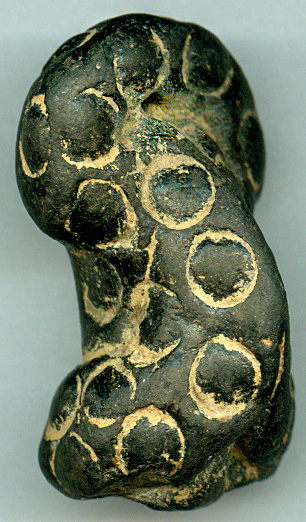
Strange Indus Valey
Snake Eye Bead

Ancient Buddhist terra cotta
Eye Bead from Sri Lanka
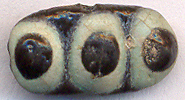
15 * 7 * 3 mm
Ceramic Eye Beads
Early historic time
600 B.C. - 100 A.D.
These beads are very rare!
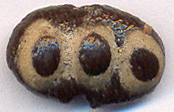
13 * 8 * 3 mm

11 * 8 * 4 mm |
Protecting
Eyes against evil eyes
The symbolic eye can also be seen as an expression of thought-intentions
directed from one human to another. In daily life, no matter if it was 2000 years ago
or in a Buddhist Newari house in Patan in Nepal today, the envious look from
the neighbor can do you harm. When you apply your eye of awareness on him
and his actions, he knows that you know through that very third eye what
he is thinking and hence he will mend his ways or at least
his evil thought power will be neutralized to a certain extent.
Apart from our western secular societies, I think that almost all
cultures more or less still have this animistic way of thinking reality. That is why
the magic eye bead is still much in the top of the bead collector’s pyramid.
Evil eyes can also be associated with the appearance of bad luck or unfortunate destiny.
It seems like Eye-beads were used from the middle to the far
East as a strategy for repelling the energies of the evil eye.
Hence we find the ancient culture of eye-beads all the way from Egypt,
where they were placed in royal tombs, to India and China where the
personal possession of an eye bead acted as a shield to repel negative forces.
The occult logic behind this use of eye beads can be illustrated in
the common saying: an eye for an eye.
The striped formations or the eye design of the Dzi bead were made to
ward of negative energies.
The good eyes on the bead acted as a metaphysical antibiotic defence.
Even the design of
the bead itself played
a great role.
The smooth roundness of a beautiful bead
acted like a
totem with the ability to ward off evil forces.
This last aspect reflecting the very design of beads actuallyincludes
all types of beads:
If a bead is beautifully
designed it will in itself – even without eyes or magical stripes -
act like a repellent against the mosquitoes of evil thoughts.
MAGIC EYE BEADS AS FOCUSPOINTS OF CONSCIOUSNESS AND THOUGHT POWER
In a way all
beads are like amulets - if one thinks they are. The 'amuletic'
power of beads can never be isolated from the particular belief
system in which the owner of the bead orients himself.
In this
way the world is constructed out of collective minds accepting the same
story told reality.
To see the world as a projection of thoughts is in fact very close to Indian religious philosophy. However where we in the west tend to
describe all mind made realities as unreal and positivistic science as
real, the ancient Indian philosophy is one step ahead in pointing out
long before the quantum physics that the observer is actually creating
the observed.
So when I in the beginning said that beads have power when one thinks
them to have it, it is not at all a positivistic or sceptic statement. Consciousnes do create the world to a much greater extent than science so far has accepted. Seen in the light of this biocentrism, the
ancient beads do have power - because they have been charged with
your consciousness and thought intentions, and before that from countless ancient generations of humans.
Beads as amulets - A strong and focused mind attracts a strong eye bead
All ancient eye beads from greater India are in this way true amulets. But
the power of a bead increases with beauty
and the degree of good artistic design.
The very shape of the bead formed an intricate component of
it's potency.
Why? Simply because the
extraordinary bead attracts more will power-attention than an
insignificant and poorly made bead.
In a way only a strong focused and non wavering mind deserves a truly magic bead.
The magic of the bead is created through that awarenes field itself. It becomes the perfect focuspoint for our attention and concentration. This mechanism shows the deeper animistic psycology behind the ancient amulet. Consciousnes has often been described in methaphors of light. Hence the blooming of consciousns is called 'enlightenment'.
This is also why a magic bead in most cases is an Eye Bead. This Eye is both recieveing, mirroring and sending your own conscious light, amplified and focused through the eye of the bead in the same way as normal diffused light is transformed into laser light when it is projected through a ruby.
So what precious stones like rubys and diamonds can do, so can the Eye Bead.
Stone beads are the worlds oldest art form. Seen in the light of the this third eye,
the bead is also among the worlds oldest amuletic tools of magic!
Today the knowledge of the power of the Indus Valley Eye Beads has been
lost. Only the mainly Tibetan dzi-beads are still recognized as powerful
amulets. But the Indus beads
are sleeping beauty's from a far older culture than the Tibetan. The
Indus bead is like a dormant power plant. It just needs your
recognition to wake up from millennia's of sleep.
|
In the
Vedas we find no particular emphasis on stone beads as amulets.
The amulets of the Vedic times have more resemblance to the amulets worn
by Tantric Yogis. In these amulets we find the extensive use of
materials from the animal and vegetable kingdoms plus the use of pearls
known as mani, jewel. It is like S. B. Deo writes in his book,
'Indian Beads':
It is surprising that so few should have been used which are not
perishable. p.39
Even though Hindu Nationalist do not like to hear it, it seems that the
importance and use of magic beads is older than the Vedas, reaching back
to the pre-Vedic time of the Indus Culture. |
Eye Beads in islam
In islamic cultures Eye
Beads have and do still play an important role. For further information
I recommend that you read Glass bead expert
Torben Sodes article about Magic Glass Beads
|
|
|
|
Magic Buddhist beads as cultural ambassadors
Here you can see a wonderful Bhaisajyaguru eye bead from Afghanistan.
It once again shows that the bead hole itself actually can serve as a magic Eye!
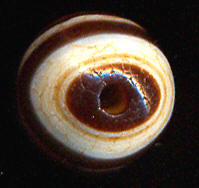
14 * 14 mm
In the section displaying etched beads most of the beads are of Buddhist origin with Buddhist symbols.
As mentioned before the Vedic Hinduism did not attach much importance to stone beads.
In prehistoric time stone beads were an essential part of the Indus Valley Culture
and in historic time the culture of stone beads more or less can be linked to the Buddhist culture.
In Tibetan Buddhism the use and understanding of magic beads plays a major role.
This stone bead culture with its symbolic axis around the magic eye
has a wonderfull artisitic peak expression in the Dzi-beads.
The artistic power and the mystic fascination of Dzi-beads have made them ambassadors
of Tibetan Buddhism all over the globe. In this way it seems that the Tibetan bead culture
and understanding has become a mainstream trend for Buddhists in the far east.
But the fascination of the Dzi-beads has spread to the west as well where you will
not be able see Sting performing a concert without his beloved 9 eyed Dzi-bead.
The upper class of the western world is 'converting' to Buddhism these years. Buddhism has in many ways
views that are far more compatible with a modern afluent way of living than Christianity can offer.
Holywood has always been in love with Tibet and the Dalai Lama. But this conversion is now further
amplified by the increasing interest for Meditation and mindfullness. Hinduism can not, with its caste system and
Disney like Gods, offer much. Hoverever, Buddhism can with its emphasis of compassion and also logic
offer a narrative frame that with a little updating fits perfectly to this post modern world. |
|
Various Magic Eye Beads
|
|
In the ancient understanding of bead magic the eye bead has always had a special importance.
Eye Beads made of Glass
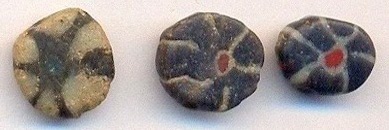
9 * 2 mm -
9* 7 * 2 mm - 8
* 5 * 2 mm
These rare Eye
Beads are from the early historic time -
Most probably
from the Taxila period 300 BC- 100 AD |
|
Wonderful
Indus Valley Eye Beads |
|
|
|
|
|
|
 |
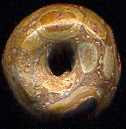 |
|
Magic eye bead is from the
Indus Valley Civilization 3000-1500BC
|
|
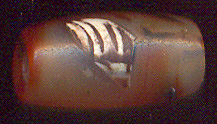 |
 |
15 * 8 mm
A strange fossil eye bead from the Indus Valley Culture
|
|
|

19 * 6 mm
Magic eye bead is from the
Indus Valley Civilization 3000-1500BC |
 |
|
|
|
|
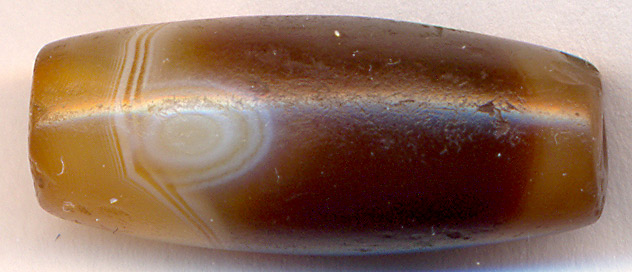 |
 |
|
24 * 10 mm
Translucent eye
bead
Indus Valley civilization 3000-1500BC
|
|
|

This beautiful
translucent natural eye bead is from the
Indus Valley Civilization |
 |
|
|
|
|
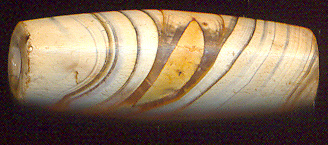 |
 |
|
25 * 10 mm
A mysterious colored agate Eye Bead.
|
|
|
|
|
|
Bead with a crystal eye |
|
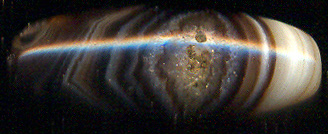
In this old bead the eye is
made of crystal
Period: Around 1000 A.D.
|
|
Sulemani Eye Beads |
|
 |
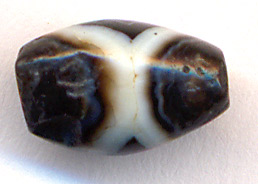 |
|
These little but perfect Sulemani agate eye bead is dating back to the Mauria
period
300 BC - 100 AD.
The backside of this bead is equally beautiful.
8 * 5 mm |
|

Front 7 * 5 mm |

Back |
|
This small bead
has an eye on the front and back side. It is made out of the
real Sulemani agate:
Solomons agate

Solomons agate Eye Bead
Amadalpur - Haryana
|
|